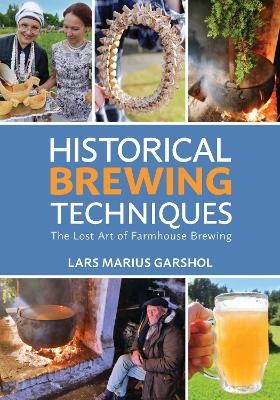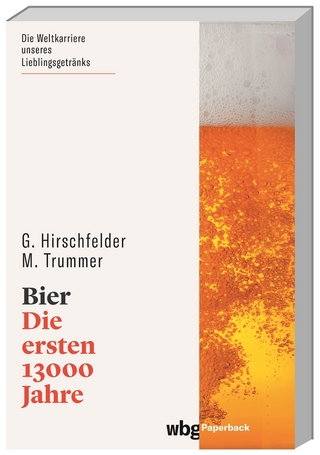
Historical Brewing Techniques
Brewers Publications (Verlag)
978-1-938469-55-8 (ISBN)
Lars Marius Garshol is a Norwegian software engineer that travels the world to learn more about beer. Garshol spent five years researching various aspects of brewing at remote farmhouses throughout Scandinavia and the Baltic countries. He is the author of LarsBlog, a blog devoted to sharing his discoveries and travels as he researches the lost art of brewing in northern Europe, Historical Brewing Techniques: The Lost Art of Farmhouse Brewing, and a book on Lithuanian beer. He lives with his wife and children in Rælingen, Norway.
Table of Contents
1 Understanding farmhouse ale
1.1 The world of yesterday
1.2 Kaupanger: First meeting with the tradition
2 History 35
3 Malt 47
3.1 Stjørdal: malt-making hot spot
3.2 The types of grain
3.3 Barley varieties
3.4 Maskin, portrait of a barley variety
3.5 How the grain was grown
3.6 Steeping and sprouting
3.7 Drying methods
3.7.1 Very pale, unsmoked malts
3.7.2 Lightly smoked, hot-dried malts
3.7.3 Heavily smoked malts
3.7.4 Caramel malts
3.7.5 Strong, uneven heat
3.7.6 Undried malts
4 Yeast 95
4.1 Voss: Discovering kveik
4.2 First lab analysis
4.3 Yeast, wild and domesticated
4.4 The yeast revolution
4.5 Yeast on the farms
4.6 Origins of the yeast
4.7 Yeast species
4.8 The family tree of yeast
4.9 Kveik, what we know
4.10 The non-kveik farmhouse yeasts
4.11 Bread yeast
4.12 Dying out
4.13 Kveik renaissance
4.14 The word “kveik”
5 Brewing process 155
5.1 Hornindal, Norway
5.2 Stone beer
5.3 Raw ale
5.4 Boiled ale
5.5 The mash boiled
5.6 Complex mashes
5.7 Keptinis
5.8 The great stove
5.9 Vsekhsvyatskoye, Russia
5.10 Understanding oven-based beers
5.11 The mash fermented
5.12 The evolution of brewing processes
6 Beer in the life on the farm 217
6.1 Harvest ale
6.2 Ritual beer
6.3 Superstition
6.4 Brewers or brewsters?
6.5 Equipment
6.6 Preparations
6.7 Grinding
6.8 Water
6.9 Carbonation
6.10 Oppskåke
6.11 Cellaring
6.12 Drinking vessels
6.13 Serving beer
6.14 Beer flaws
7 Spices and adjuncts 277
7.1 Hops
7.2 Juniper
7.3 Sweet gale
7.4 Grand wormwood
7.5 Caraway
7.6 St John's Wort
7.7 Bitter orange peel
7.8 Yarrow
7.9 Tansy
7.10 Bay laurel
7.11 Wild rosemary
7.12 Heather
7.13 Others
7.14 Adjuncts
7.14.1 Potatoes
7.14.2 Bran
7.14.3 Carrots
7.14.4 Peas
7.14.5 Honey
7.14.6 Other adjuncts
7.15 Filter materials
7.15.1 Straw
7.15.2 Alder sticks
7.15.3 Other
8 The drink problem
8.1 Small beer
8.2 Rostdrikke
8.3 Kvass
8.4 Birch sap beer
8.5 Juniper berry beer
8.6 Mead
8.7 Sugar beer
9 Brewing like a farmer
9.1 Carbonation
9.2 Working with kveik
9.3 Working with farmhouse yeast
9.4 Brewing with juniper
9.5 Making your own malts
10 Styles and how to brew them
10.1 What is farmhouse ale?
10.2 Recipes
10.3 Raw ales
10.3.1 Brewing raw ales
10.3.2 Kornøl
10.3.3 Sahti
10.3.4 Island koduõlu
10.3.5 Kaimiškas
10.3.6 Danish landøl
10.4 Dark, smoky ales
10.4.1 Stjørdalsøl
10.4.2 Gotlandsdricke
10.4.3 Landøl from south Funen
10.5 Brown boiled beers
10.5.1 Heimabrygg
10.5.2 Telemark, Norway
10.5.3 Hallingdal
10.5.4 Swedish farmhouse ale: Öxabäck
10.6 Oven beers
10.6.1 Seto koduõlu
10.6.2 Oven-mashed Russian farmhouse ale
10.6.3 Chuvashian farmhouse ale
10.6.4 Sur
10.6.5 Keptinis
10.7 Fermented mash
10.7.1 Luumäki-style
10.7.2 Vanylven-style
10.8 Stone beer
10.9 Other regions
10.9.1 Corn ale
10.9.2 English farmhouse ale
10.9.3 Welsh farmhouse ale
10.9.4 Westphalian farmhouse ale
10.9.5 Aludi
10.9.6 Oat beer
11 Today and tomorrow
11.1 Baltic time capsule
11.2 The Baltics today
11.3 Status in the west
11.4 Farmhouse ale in the 21st century
11.5 Into the future
12 Acknowledgements
13 Bibliography
13.1 Archive sources
13.2 The database
13.3 Published sources
13.4 Unpublished sources
13.5 Interview sources
| Erscheinungsdatum | 29.05.2020 |
|---|---|
| Verlagsort | Boulder, CO |
| Sprache | englisch |
| Maße | 179 x 252 mm |
| Gewicht | 993 g |
| Themenwelt | Sachbuch/Ratgeber ► Essen / Trinken ► Getränke |
| ISBN-10 | 1-938469-55-0 / 1938469550 |
| ISBN-13 | 978-1-938469-55-8 / 9781938469558 |
| Zustand | Neuware |
| Informationen gemäß Produktsicherheitsverordnung (GPSR) | |
| Haben Sie eine Frage zum Produkt? |
aus dem Bereich


